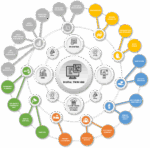
Five Secrets to a Successful BIM Execution Plan
A well-prepared building information modeling (BIM) execution plan means the difference between a successful project and a botched one.
Discover the foundational, step-by-step secrets you need to build an effective BIM execution plan:
- Establish the Big Picture
- Gather Inputs and Perspectives
- Set Actionable Steps
- Encourage Ownership and Collaboration
- Set BIM Best Practices & Procedures
1. Establish the Big Picture
Write a Vision Statement
We believe in writing a vision statement for each project to help clients and stakeholders understand what they’re working toward.
What do you want to achieve with this project? How does BIM further your ability to get there? Ultimately, the owner will pay for the project and use the building for years to come, so make sure you understand what success looks like in their eyes.
These visions can vary widely. On one of our projects, the owner wanted to open their stadium on time for a major concert with Metallica & the San Francisco Symphony Orchestra, while another project had the transformational goal of creating a healthcare facility that elevated the standard of care for patients and healthcare providers. These visions should ultimately guide your BIM execution plan.
Build the Roadmap
Once you understand the vision, think high-level about key objectives and meaningful goalposts that will help your team achieve the desired outcomes of your BIM execution plan.
Done right, a BIM execution plan serves as a roadmap for your entire team, with information about guidelines, procedures, expectations, and standards for BIM integration. Depending on your project’s unique needs, the BIM execution plan may reflect various stages, including design, preconstruction, construction, operation, and management.
As the project evolves, you’ll need to keep the BIM execution plan updated based on changes to stakeholders, workflows, platforms, deliverables, or scope.
2. Gather Stakeholder Input and Perspectives

Start by Asking Questions
We believe in bringing the right people, with the right information, together at the right time. To build a successful BIM execution plan, you’ll need to gather perspectives from various stakeholders.
Host sidebar meetings with various stakeholders to get their unique perspectives instead of waiting until the kickoff meeting to hear potential changes and concerns for the first time. For instance, you could:
- Ask the owner to paint a picture of what success looks like for them.
- Go out in the field and seek your superintendent’s input—how do they need to receive information in the field to enable the construction process?
- Talk to the facilities manager, who will consider operability factors that others might overlook, such as maintenance accessibility.
Use Inputs to Kickstart Collaboration
Take your initial conversations and start running ideas by your different stakeholders. What do they think about achieving this timeline for underground coordination? Do they have experience with the platform you’re considering using for the Common Data Environment (CDE)?
By soliciting feedback and starting collaborative conversations early in the process, you can help increase buy-in and team cohesiveness once the BIM execution plan is in action.
3. Set Actionable Steps
Set Realistic Milestones
Be realistic in how you align the BIM execution plan with the construction project. For example, if you know when concrete pours will happen, think backward from there to define when you need your slab penetrations, embeds, and inserts worked out. That way, your BIM plan can be as valuable as possible.
Ask for your team’s input about the timeline, as people are more likely to agree to a schedule they had a role in creating. Then, aim to get their explicit commitment to the finalized timeline.
Be Clear and Concise
Some projects—like government or airport work—will require behemoth stacks of documents spanning 200 pages (or more!) of details and requirements. But believe it or not, the ideal length of a BIM execution plan is approximately 20 pages, and after that point, you should use appendices. If your BIM execution plan has too many pages for the project size, you risk it never getting read. Imagine it ending up, in its printed form, as a doorstop in the job site trailer. Don’t let that happen—keep the BIM execution plan short and precise!
Break the Work into Stages
Even at 20 pages, BIM execution plans can be overwhelming. Break the building, level, or project plan into digestible steps so you’re not putting everything on your team all at once.
Find stages within your process where each discipline can put its focus. For example, if you’re working on fire protection, narrow the concept down—for instance, a team could address a specific, concrete aspect of fire protection, like ductwork.
4. Encourage Ownership and Collaboration
Clarify Responsibilities
Ensure everyone knows their specific tasks and outcomes and outline these in the BIM execution plan. Each task must have a singular owner to maintain accountability, from architects focusing on design details to construction managers overseeing timelines and safety.
Add a contact list in a table at the end of your BIM execution plan, detailing names, companies, roles, and email addresses to facilitate direct communication and quick issue resolution. If a trade is having trouble meeting the coordination schedule, who do they call? If someone makes a mistake syncing the model on the Autodesk Construction Cloud and a week of work is lost, who is the tech expert responsible for helping them fix the problem?
Decide on Information Exchange Protocols
Email is arguably the worst form of communication during a BIM project—and yet it’s frequently the go-to choice for exchanging information.
Instead, establish protocols that account for what information needs to be exchanged, who needs what, when it’s needed, and what medium will be the most effective for your project.
5. Set BIM Best Practices & Procedures

Define the Common Data Environment
Every BIM project implements a centralized data environment (CDE) through software like ACC, Procore, and Aconex, which allows project stakeholders to access and exchange real-time project data. This helps preserve transparency around the most recent design model.
Your BIM execution plan should specify which software platform to use for each piece of your project. Outline best practices for utilizing each type of software for optimal communication and collaboration.
Include Project Reference Information
Your BIM execution plan should also include essential project reference information, such as alignment points and installation benchmarks, to align the model with actual field conditions. Establish an order of precedence for documents to resolve any discrepancies between the spec book and drawings.
Model Quality Control Procedures
In your BIM execution plan, explain what aspects of model quality you’ll check—and why. Being specific about quality control procedures and their purpose helps everyone get on the same page and motivates them to do their part.
As for quality assurance, be clear about your expectations and what you’ll be checking to encourage your team to ensure the model is correct the first time. Remember, quality assurance helps your project more than quality control.
Define Working Procedures
Defining working procedures plays a crucial role in the success of your project. These might include file-naming conventions, exceptions, tech infrastructure needs, the process for communicating with other trade partners, deliverable expectations, and timelines for completing coordination changes.
The more granular and precise your working procedures, the more accountability you can introduce.
Organize a “Coordination Week”
Set up a “coordination week” workflow that defines your meeting schedule and cadence. Include the days of the week the team will meet and what time the meetings will be. Define the authoring software and version control for every deliverable in your BIM execution plan and include the expected weekly deliverables for your team members—like target dates for trades to upload their updated models.
Enhance the Effectiveness of Your BIM Execution Plan with VIATechnik
A well-written BIM execution plan is the difference between a stressful project for your team and a motivating, productive one.
As the leading BIM, VDC, and construction technology firm in the United States, VIATechnik has decades of experience supporting our clients in taking their projects to new levels of success.
Contact us today to learn how we can help you use BIM to revolutionize your workflows and drive better project outcomes.
FAQs
What are the 5 steps of BIM?
The five steps of BIM typically include planning, designing, constructing, operating, and managing. These steps guide the lifecycle of a building project, ensuring seamless collaboration, efficient workflows, and data integration from concept to completion and beyond.
Who prepares the BIM execution plan?
The BIM execution plan is usually prepared by the project team, including BIM managers, project managers, and key stakeholders such as architects, engineers, and contractors. It ensures alignment across all parties involved in the project.
What is the difference between a BIM implementation plan and BIM execution plan?
A BIM implementation plan focuses on the adoption of BIM processes and technologies within an organization or project team. A BIM execution plan, on the other hand, outlines the specific guidelines, workflows, and responsibilities for applying BIM on a particular project.
What is the BIM plan?
The BIM plan is a document that defines how Building Information Modeling will be used on a project. It includes details about processes, standards, roles, and software to ensure effective collaboration and project success.



